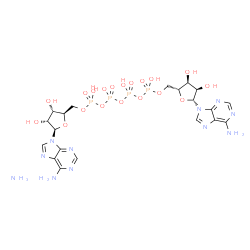P1,P4-二(腺苷-5′) 四磷酸 铵盐

P1,P4-二(腺苷-5′) 四磷酸 铵盐结构式

|
常用名 | P1,P4-二(腺苷-5′) 四磷酸 铵盐 | 英文名 | A[5']P4[5']A AMMONIUM SALT |
|---|---|---|---|---|
| CAS号 | 102783-36-8 | 分子量 | 853.417 | |
| 密度 | N/A | 沸点 | N/A | |
| 分子式 | C20H31N11O19P4 | 熔点 | 123 - 125 °C | |
| MSDS | 美版 | 闪点 | N/A |
|
Adenine dinucleotides: a novel class of signalling molecules.
J. Auton. Pharmacol. 16 , 325-328, (1996) 1. Adenine dinucleotides (Ap3A, Ap4A, Ap5A, Ap6A) are stored in secretory granules of thrombocytes, chromaffin cells and neuronal cells. After release into the extracellular space, the dinucleotides exhibit divergent biological effects on a variety of target ... |
|
|
Selectivity of diadenosine polyphosphates for rat P2X receptor subunits.
Eur. J. Pharmacol. 367 , 19-123, (1999) The pharmacological activity of diadenosine polyphosphates was investigated at three recombinant P2X receptors (rat P2X1, rat P2X3, rat P2X4) expressed in Xenopus oocytes and studied under voltage-clamp conditions. For the rat P2X1 receptor, only P1,P6-diaden... |
|
|
Diadenosine polyphosphates in insulin-secreting cells: interaction with specific receptors and degradation.
Diabetes 47 , 1727-1734, (1998) A role of diadenosine polyphosphates as second messengers was suggested for insulin-secreting cells. It has not yet been investigated whether specific receptors for these compounds exist and how these extracellular compounds and their degradation products may... |
|
|
P1,P4-diadenosine 5' tetraphosphate induces nitric oxide release from bovine aortic endothelial cells.
FEBS Lett. 427 , 320, (1998) Since the infusion of P1,P4-diadenosine 5' tetraphosphate (Ap4A) into animal models induces vasodilation [1,2], the present study was performed to determine whether Ap4A induces the release of nitric oxide (NO) from endothelial cells. Ap4A induced NO release ... |
|
|
Diadenosine polyphosphate-stimulated gluconeogenesis in isolated rat proximal tubules.
Biochem. J. 323 , 451-456, (1997) Diadenosine polyphosphates released into the extracellular environment influence a variety of metabolic and other cellular activities in a wide range of target tissues. Here we have studied the impact of these novel nucleotides on gluconeogenesis in isolated ... |
|
|
Diadenosine polyphosphates inhibit adenosine kinase activity but decrease levels of endogenous adenosine in rat brain.
Eur. J. Pharmacol. 322 , 5-42, (1997) Findings in peripheral tissues that diadenosine polyphosphates (Ap(n)As) activate 5'-nucleotidase activity and inhibit adenosine kinase activity in vitro led us to test the hypothesis that Ap(n)As and analogues thereof, through such actions on purine enzymes,... |
|
|
Characterization of ATP and P2 agonists binding to the cardiac plasma membrane P1,P4-diadenosine 5'-tetraphosphate receptor.
Biochim. Biophys. Acta 1375 , 61-72, (1998) P1,P4-Diadenosine 5'-tetraphosphate (Ap4A) acts as an extracellular modulator through its interaction with purinoceptors. Our laboratory has demonstrated the presence of an Ap4A receptor in cardiac tissue [1,2]. Due to the rapid hydrolysis of ATP by cardiac m... |
|
|
Diadenosine polyphosphate-mediated activation of phospholipase D in isolated rat liver cells.
Cell. Signal. 10 , 505-509, (1998) Diadenosine polyphosphates (ApnAs) can, through interaction with appropriate purinoceptors, affect a range of cellular activities. Ap4A, the most prominent naturally occurring diadenosine polyphosphate, stimulates alterations in intracellular calcium homeosta... |